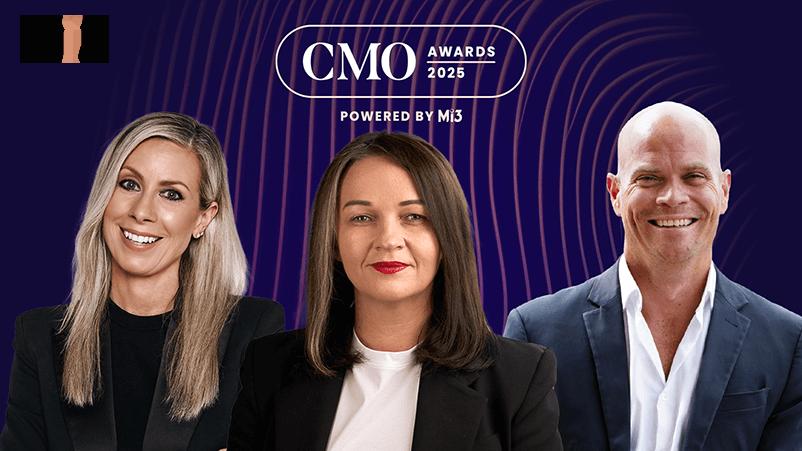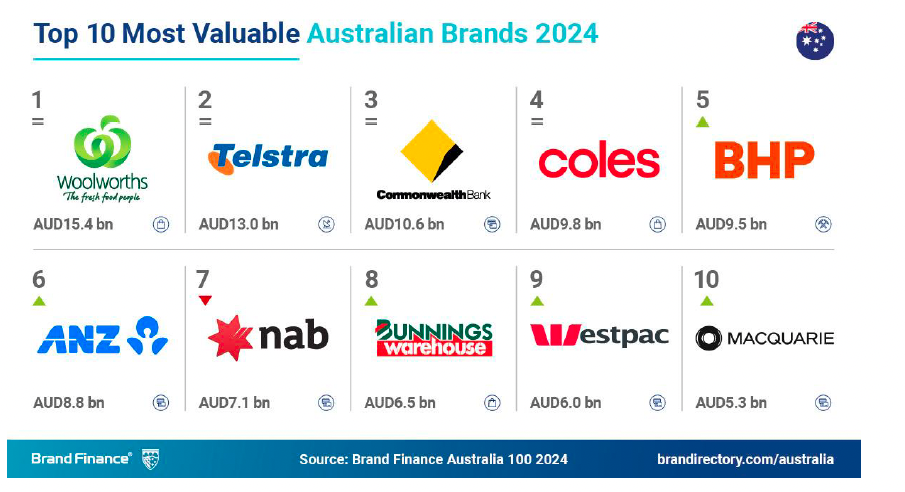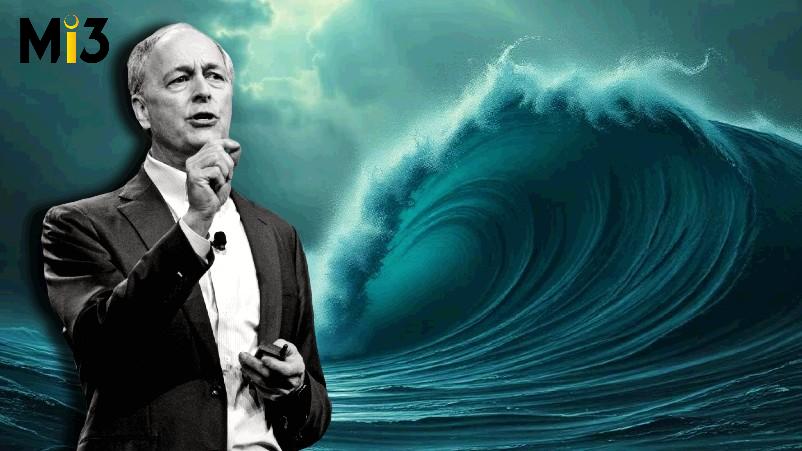The CMO Awards Podcast Ep8: Top marketers flipping performance for brand and posting double digit gains: Michael Hill, Reflections Holidays, Allianz CMOs recalibrate spend, metrics, creative – and win

What you need to know:
- Three of this year’s CMO Awards finalists – Michael Hill CMO, Jo Feeney, Reflections Holidays CMO, Pete Chapman and Allianz Australia GM of customer strategy and marketing, Laura Halbert – have revealed how they’ve been able to flip the switch from demand to brand in the latest CMO Awards podcast episode and reap the commercial dividends.
- Under the moniker, ‘Life’s better outside’, Chapman has been stridently seeking engagement with a more discerning “outdoorsy” audience that puts nature, not novelty, first. From only 10 per cent of budget going on brand versus performance, it’s completely switched the other way. Last year, Reflections also underwent a rebrand complete with new positioning and brand look. And the results are all up, from double-digit NPS to unaided brand awareness and loyalty.
- At Michael Hill, Jo Feeney started with brand and customer insights first, then tackled a price promotions advertising legacy in her first year to shift the retailer towards a brand-led market approach. Per Feeney: “We had to reset ourselves as a brand first and we spent a couple of years doing that, really to get permission to do a rebrand. We couldn’t have gone from zero to 100, we actually had to start to retell the story of Michael Hill.”
- Laura Halbert debuted Allianz’s new brand positioning work, ‘Care you can count on’ in May. She’s already reporting a 15-point lift in brand awareness thanks to a creative approach grounded in leveraging distinctive brand assets that take their cues from a distinctive level of care Halbert could see existed inside the organisation before even joining the insurance giant.
- For all three, balancing the emotional connection to marketing’s work with the hard data and metrics that demonstrate why it’s effective and resonating has been a critical ingredient in the transition.
- Keeping an eye out for smart short-term optimisations and improvements is also a way to counterbalance any short-term hits as marketers switch to long-term brand building, says Chapman. In his case, this meant improving the call centre’s responsiveness to inbound calls, filling the sales funnel and improving responsiveness.
- Proactively working with the c-suite and executive team, “opening the kimono” and even admitting where things are not working has been another must for this trio of CMOs.
- In Halbert’s case, that meant revealing first creative efforts in testing failed. “We went back to the executive team and board and said, we didn’t do it, we’ve got to try again,” she says. “By showing those moments and that it’s not all shiny, it’s not all well-rehearsed, and it’s not all perfect, and trying to show them a media model, telling them what you’re struggling with, opening it up and letting them in, we haven’t had an issue… because we’ve got the relationships and we’ve done the work and we’ve got the maths.”
- Get the full podcast here.
My closest relationship here in the business is our CFO; we work hand-in-glove. I spent a lot of time building that relationship, and it came from a place where, previously, really, she was controlling marketing, and certainly controlling anything that it did in a meaningful way. We spent a lot of time together. We're incredibly aligned on now on the power of building brand to drive long-term demand and working on optimising the business to make the most of short-term demand. With that advocacy, we could really take that to the board.
Brand evolution: It’s in the sights of every marketer, but how do you honour the legacy while seeking a new narrative that grabs attention, signals distinctiveness, and builds loyalty? How do you prove it’s worth investing in brand not just demand internally to a CFO? What team structures and measures are better for driving a brand-led marketing approach? And what does it take to avoid what Mark Ritson calls “the pornography of change” in your creative and brand execution for the sake of it, versus innovating to ensure continued cultural relevance and commercial success?
Three of our CMO Awards finalists and winners – Michael Hill CMO, Jo Feeney, Reflections Holidays CMO, Pete Chapman, and Allianz Australia general manager of customer strategy and marketing, Laura Halbert – have made brand their mantra and mechanism for commercial success.
Each of the businesses they work for are in different categories, and sit at different lifecycle stages of brand maturity. Yet similarities in how they’re building brand are in evidence. All have diligently captured then leveraging data and customer insight, plus worked to identify and stick to brand values. They’ve recalibrated media spend, committed to long-lasting creative and content that oozes distinctive brand assets, multi-year horizons – while simultaneously optimising the short. What’s more, they’ve sought whole-of-company buy-in, leveraging baseline metrics and commercial smarts to win over executive peers.
Reflections Holidays: Flipping 90 per cent performance to 90 per cent brand
Take Reflections Holiday, a relatively young brand representing 40 holiday parks in Australia in a category Pete Chapman, who was 21st in this year’s CMO Awards, describes as “relatively unsophisticated”. As the business has transformed its operating model and committed to becoming a social enterprise, building brand became this CMO’s strategic quest.
Under the moniker, ‘Life’s better outside’, Chapman has been stridently seeking engagement with a more discerning outdoors audience that puts nature, not novelty, first. From only 10 per cent of budget going on brand versus performance, it’s completely switched the other way. Last year, Reflections also underwent a rebrand complete with new positioning and brand look.
“We really flipped what the category could be thought of on its head, and with that, we really needed to start building out our own corner of the market and appealing to that much more discerning outdoorsy audience than had ever considered holiday parks before,” Chapman says.
“Because the product had evolved and our audience had grown and changed with that, the current brand itself was really holding us back from reaching our potential. So we needed to evolve the brand positioning and visual identity and make the shift from saying we’re just like the other guys, which was what we had set out to do at the start, to drive some sort of familiarity and relevance to the brand, to saying we’re nothing like the other guys.”
Execution is everything
As a former agency leader, Chapman has been through many rebrands and says manifesting a new look and feel is just the tip of the iceberg. So while he can talk at length about sonic assets, use of one-shot footage at properties in 30-second ads to drive authenticity, and the visual language he’s invested in, he’s also keen to point out how much effort went into employee engagement.
“I’ve seen, certainly in my time, heaps of brands put so much effort into the development and sign off and perhaps launch of a rebrand, only to do a really rubbish job of executing it. We spent months and months planning the launch and rollout,” Chapman says. “We then made the choice to launch it at our annual conference to our people all at once before anyone else knew about it. We put as much effort into telling that story as we did telling the market our story.”
A pop-up shop was available at the conference so staff could immediately get new-look uniforms as soon as the rebrand launched on stage. Signage at the parks was all switched over. An above-the-line advertising campaign began the same night and guest communications were all changed at once.
“Your people care a lot more about your brand than anybody else does, because it’s what they get up for in the morning to go and it’s what they believe in – ideally – day in and day out… What it meant was our people owned the rebrand, and overnight, we had 520 advocates telling our story for us,” says Chapman.
Helping Chapman was the group’s first in-house creative director. “We look to own the thinking and certainly the strategy in-house, then look externally to see who the best person is, project to project, to bring that to life,” he says.
Chapman is also a believer in solidifying brand authenticity through ambassadors and partnerships, and has struck relationships with the AFL GWS Giants, NRL Newcastle Knights and Surfing Australia. The latter has seen Reflections launch its own junior surfing tournament onsite at its properties. A major fishing brand partnership is also on its way.
“If you can build that triple win, then start with the win for the fan or customer, which will deliver a win for you and for the partner as well. Then you’re going to find a formula that works,” says Chapman. “Then you need to have measures in place that can really demonstrably show the impact that’s having on your consumption audience.”
The new brand strategy made for some exceptional – and ironically, short-term – results for Reflections, Chapman points out. These include 10.1 per cent year-on-year, topline revenue growth between February 2024 and February 2025, a +15.9 per cent lift in NPS, and a 20 per cent increase in loyalty club membership.
I remember some of the early conversations when I did things like taking off price points and trying to reduce the discounting we were doing … I'm sure there was some hallway whispers saying 'she's crazy, she doesn't know what she's doing' … Brand is hard for people to get their head around to really understand: 'What do you mean – just telling a really wonderful story is going to be more engaging and get more attention from someone, than showing them what they need to buy at what price?' You have to gain that trust by proving out the results and showing people.
Michael Hill: Price promotion, healthy paranoia, and finding brand foundations in the founder story
For Jo Feeney, #12th in this year’s CMO Awards, the lack of clarity on what Michael Hill stood for, over-reliance on product and price promotions, limited insight into what customers thought, and the absence of a narrative around the retailer’s compelling lineage in fine jewellery all made rebranding a must. But you can’t tackle it all in one hit.
So Feeney’s first step was introducing brand tracking, then making the case for taking price points off advertising.
“We didn’t look sophisticated for a fine jewellery business, and we hadn’t really evolved over time,” she says. “There was an opportunity that was very clear to me, to firstly understand what is the diagnosis, and what does the customer think of our brand. We didn’t have a lot of insight or data around that, so it was an opportunity to do a really deep diagnostic of what people thought of us as, as a brand and as a business.”
Feeney also jettisoned the printed catalogues in her first year and shifted towards digital and “better media channels”, as the longer-term shift to reinvest an unprecedented 60 per cent of advertising funding into brand began. Price and product proposition began giving way to emotionally-led creative.
“We had to reset ourselves as a brand first and we spent a couple of years doing that, really to get permission to do a rebrand. We couldn’t have gone from zero to 100, we actually had to start to retell the story of Michael Hill,” says Feeney. “Resetting ourselves and getting a baseline was the really important part to then be able to even think about what could a rebrand look like.
“I remember some of the early conversations when I did things like taking off price points and trying to reduce the discounting we were doing. That was really scary for different parts of the business. I’m sure there was some hallway whispers saying ‘she’s crazy, she doesn’t know what she’s doing’. So you have to try and take people on that journey. But I do think you’re always going to have those challenges. Brand is hard for people to get their head around to really understand: ‘What do you mean just telling a really wonderful story is going to be more engaging and get more attention from someone, than showing them what they need to buy at what price?’ You have to gain that trust by proving out the results and showing people.”
Another important step in bringing the business on the journey is having them feel what you feel, says Feeney. “The shift when you can show them these pieces, they have a real emotional connection to and feel proud of, is dramatic. That has a really big impact on what you can then do in the future,” she says.
Hard metrics then qualify the customer opportunity. “Being able to look at who our customer was and who our growth customer was, and to be able to measure that, gave us a standpoint to be able to say the things we are doing are starting to have impact, and we’re starting to drive the outcomes we need,” says Feeney. “If you can’t measure it and prove things are working, you can’t continue to do more of those things.”
Even with persistently tough retail conditions, brand efforts helped turn three years of negative growth into three years of positive growth in group sales at Michael Hill: +13.1 per cent (2021), +7 per cent (2023) and +9.8 per cent (2024).
We had an amazing couple of ideas before we launched our story of our Eagle and Finch, and we drank the Kool-Aid, and thought we'd cracked it. We went to testing, and it failed. We went back to the executive team and board and said, 'we didn't do it, we've got to try again'. By showing those moments and that it's not all shiny, it's not all well-rehearsed, and it's not all perfect, and trying to show them a media model, telling them what you're struggling with, opening it up and letting them in, we haven't had an issue… because we've got the relationships and we've done the work and we've got the maths.
Connecting to care: Allianz’s new brand positioning in Australia
Laura Halbert, meanwhile, is in the early stages of a rebranding effort for Allianz Australia, debuting its new brand positioning work, ‘Care you can count on’ in May. She’s already reporting a 15-point lift in brand awareness thanks to a creative approach grounded in leveraging distinctive brand assets that take their cues from a level of care Halbert felt in her first interviews before even joining the insurance giant.
“As I got to know the business more and more, that care was everywhere; it was in the frontline, it was in the data team, and there was just an amazing amount of passion for the organisation and for our customers,” she comments. “So the first marker was just in the experience. But the wonderful thing about a German organisation is we do have data. I was flooded with all the data and all of the research that you could possibly dream of.
“When you really unpacked it and got to the bottom of things, what was clear was that it was an amazing brand, with good awareness, good consideration, lots of trust. But when you unpack it further, it wasn’t enough. Customers trust more and more insurance companies, and they’re happy to look at more and more options. We needed to be different. We needed to be distinctive. And so we went on a mission over the course of the last 18 months to really go and understand who we were right at the core.”
The new creative is a manifestation of this, introducing ‘The flight of the Finch’ direction and telling the story of a mother finch on a quest to protect her egg. It also uses Avril Lavigne’s emotive song ‘I’m with you’.
“This wasn’t about an ad. This was about our brand and who we were like, what was our soul,” Halbert continues. “We spent 18 months and we did the work right, the proper, hard brand work – we talked to the board, we talked to the executives, we talked to frontline, we talked to everyone we possibly could get our hands on. What kept coming up time and time again was this word ‘care’.
“So the next job to say to customers was, well, if we’re an insurance company that cares, tell us what that looks like you. Tell us what an insurance company that cares does, and help design our brand with us. That was the process from there.”
Allianz already has a distinctive brand asset in its sonic cue, ‘ahhh-llianz’. But it’s not enough, says Halbert.
“We know from our research that prime ministers and taxi drivers all say, ‘ahhh-llianz’. What a gift, right? So that’s not going anywhere… But it’s not enough. I can’t go around just screaming, ‘ahhh-llianz’ all the way through the town.
“We know the second-most powerful asset you can have are characters. So we worked with the team at Howatson+Co, really staring into what characters could do to really bring our personality and our soul to life through the brand.”
The Australian brand campaign is unique to this market. Even as a large global brand, Halbert says there’s plenty of flex locally.
“We work very closely with our colleagues in Germany, who are incredibly supportive to make sure that everything we do always ladders up to our bigger brand purpose. But importantly, there’s enough flex in the system to let what we call OES [operating entities] do what they need to do to be successful.”
Critical in the process was getting alignment from the beginning before going on brand repositioning journey around the objectives and key results sought, says Halbert.
“That was embedded into all of the executives scorecard. So that was great. But you need to have your leading indicators and your lagging indicators and your operational metrics all lined up too. Because it does take time for the brand work to really come through in terms of sales. You have all those things lined up so you can prove it’s on the right track,” she adds.
Optimising the short to get to the long
None of these CMOs have taken their eyes off the short term while pursuing the long, however, and each has a story to tell about optimising the lower funnel or low-hanging CX fruit while embedding the more ambitious brand plan.
“I think the smartest thing we did … was we looked at building long-term demand at the very same time that we spent a lot on optimising some very conversion-based channels,” says Reflections Holidays’ Pete Chapman. “When I came into the business, we were only answering 50 per cent of the sales calls coming in, if you can imagine that. We’re spending all of this money in performance-based media, we’re driving leads, yet we had a crap website, and we’re only answering half the calls.”
So Chapman invested heavily in a local call centre, getting results up to 60, 70, then 80 per cent.
“That supplemented any drop we had short term in changing tack without advertising,” he says. “The same thing happened when we invested heavily in the website and drove ecom conversion up, and then we got to invest in brand, which we started at the same time.”
In Michael Hill’s case, bringing on Miranda Kerr as a brand ambassador provided a short cut to building key brand attributes in market quickly.
“When you’re a listed business and you have to report to a board and show the value of what you’re doing,” Feeney says. “I certainly know that my marketing budget hasn’t increased in the last four years. In fact, it’s the opposite. When you have a distinct asset like an ambassador like that, it helps elevate and adds value to your media spend as well. That’s a really important piece. But showing the results and showing the data that we can drive from having an ambassador was critical, and proving out some of the metrics we put in place to be able to prove that value was important. There were lots of different data inputs and data points, but driving the growth of a new customer, fast tracking awareness and all of those metrics are really important to prove out the value.”
Transparency – even if it’s not working
The other thing all three marketing chiefs agree on is the need for open, honest and collaborative conversations across the organisation. All share cross-functionally as much as possible – even if the first results aren’t so crash hot – and have worked hard to build c-suite relationships.
“We opened the kimono, and said check out how we’re thinking about media, come and have a look. Give us advice. Let us know what you think,” says Halbert. “That opened up trust, and was a really important part of how we got the support.”
Being vulnerable is another must for Halbert. When the first creative ideas proved not to be right for her rebrand plans, the Allianz marketing team shared this with the board and executive team.
“We had an amazing couple of ideas before we launched our story of our Eagle and Finch, and we drank the Kool-Aid, and thought we’d cracked it. We went to testing, and it failed. We went back to the executive team and board and said, we didn’t do it, we’ve got to try again,” she says. “By showing those moments and that it’s not all shiny, it’s not all well-rehearsed, and it’s not all perfect, and trying to show them a media model, telling them what you’re struggling with, opening it up and letting them in, we haven’t had an issue… because we’ve got the relationships and we’ve done the work and we’ve got the maths.”
Chapman agrees CMOs can’t afford to underestimate the value of building relationships with influential peers internally in a collaborative way.
“My closest relationship here in the business is our CFO; we work hand-in-glove,” he says. “I spent a lot of time building that relationship, and it came from a place where, previously, really, she was controlling marketing, and certainly controlling anything that it did in a meaningful way.
“We spent a lot of time together. We’re incredibly aligned on now on the power of building brand to drive long-term demand and working on optimising the business to make the most of short-term demand. With that advocacy, we could really take that to the board.”
Having the “huge privilege” of working for a CEO who was the former Tourism Australia CMO (Nick Baker) helps too of course.
“I don’t pretend to understand the challenge of working within an executive that doesn’t understand or believe in the power of brand or marketing. But you still have to take that to the board and tell it in a way that that is going to get you buy in,” adds Chapman. “If you can work on some levers, way down the channel, way down the funnel, that can help sort of turbo charge some quick wins while you work on the longer-term wins.”





